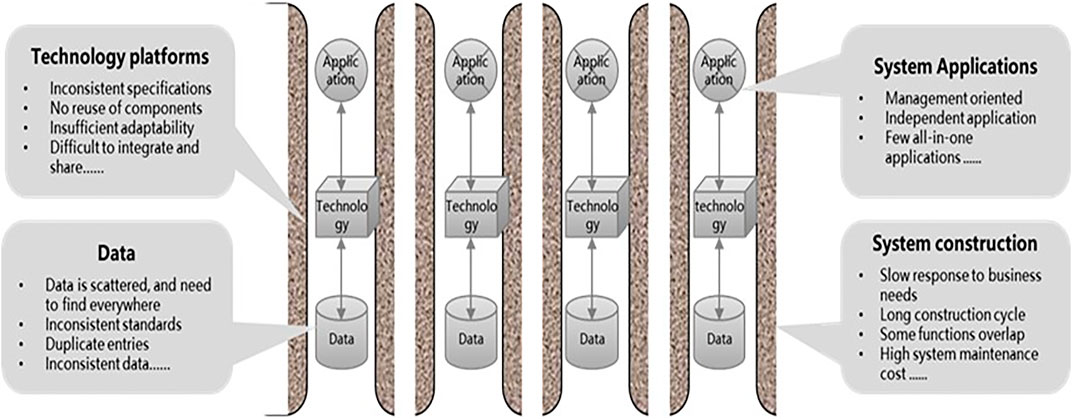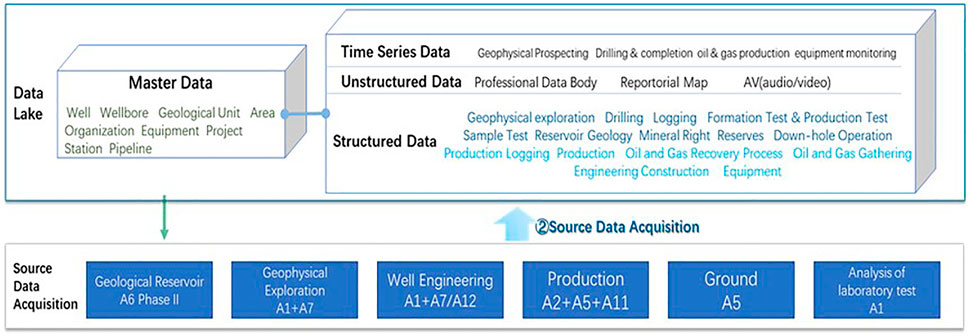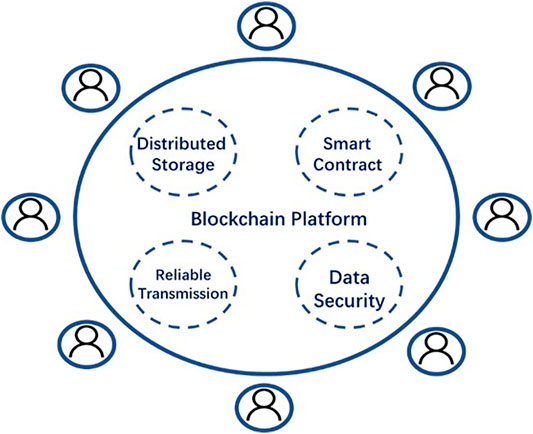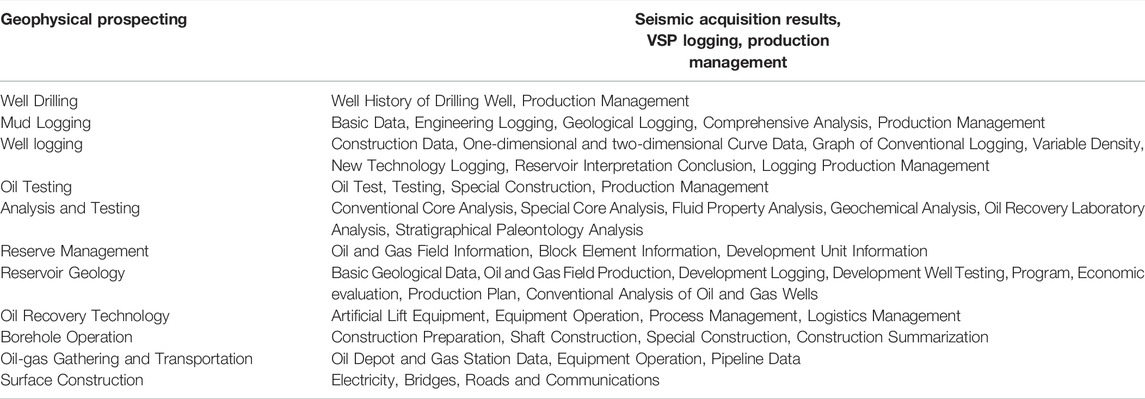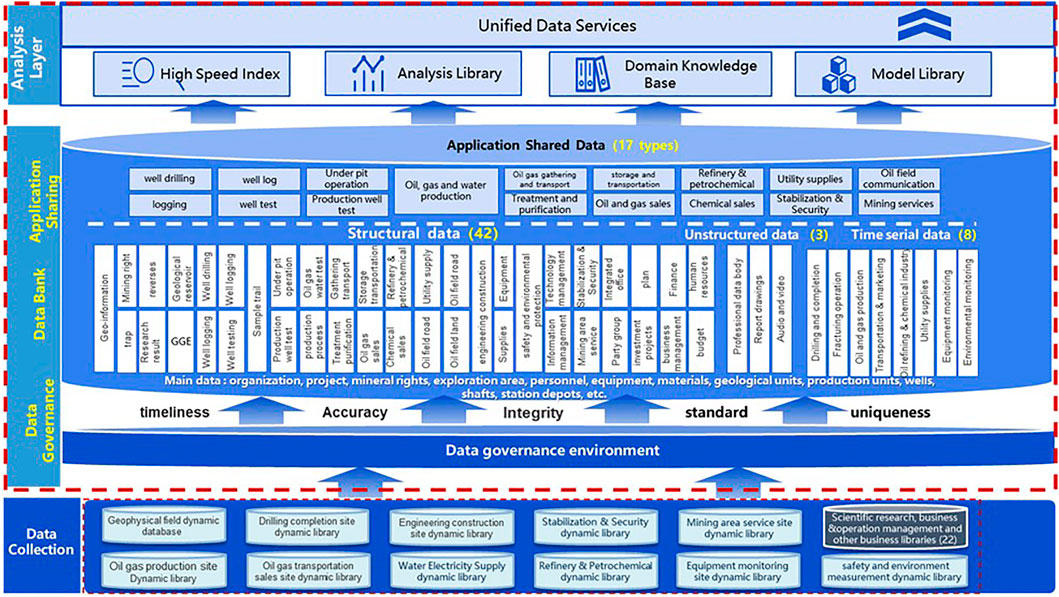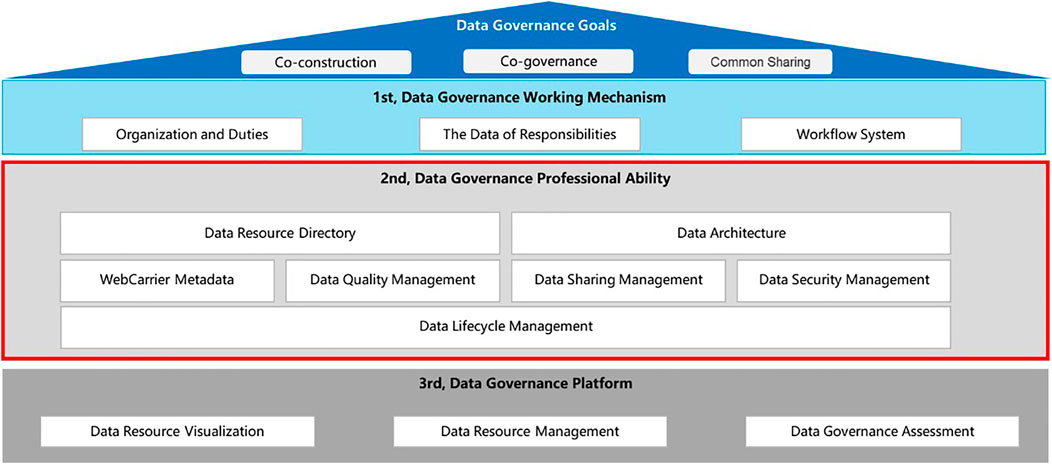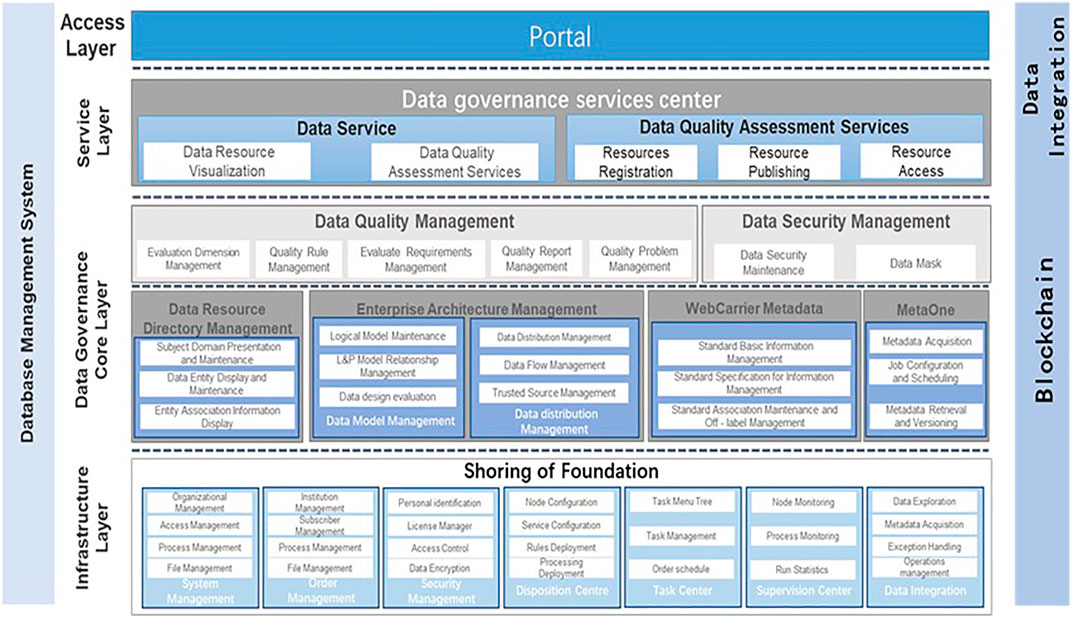- 1School of Economics and Management, China University of Petroleum, Qingdao, China
- 2Research Institute of Petroleum Exploration and Development, Beijing, China
Data gradually becomes a critical concern for the strategic resources in enterprises. Massive amounts of data with different types involved in the oil and gas industry can be obtained through IoT (Internet of Things) devices, supported by Blockchain technology with characteristics of immutability and credibility in distributed storage. Hence, credible data will be rationally used in Big Data analysis and Artificial Intelligence implementation. The global mutual trust protocol of Blockchain technology is the bridge among IoT devices, Big Data analysis and Artificial Intelligence implementation, and enables effective coordination of participation of multiple parties and ultimately break isolated island of information. Data governance is the prerequisite for data sharing. As a basic project, Data Sharing breaks data islands and business barriers, improving Data Governance capabilities in Digital Transformation and promoting high-quality development of the oil and gas industry) From the perspective of Digital Transformation, this paper reviews the current situation and problems of Data Governance by evaluating the Data Governance ability of oil and gas enterprises. Furthermore, a proposal is put forward to apply Blockchain technology to improve the Data Governance system and capabilities as the overall program of the oil and gas industry Data Governance system.
Preface
Recently the digital economy has embarked on a major era of transformation. The in-depth integration of industrial technology and information technology innovates production organization and operation methods, triggering industrial resolution and traditional industrial upgrading with new industries, new formats and new models continuing to emerge. As a traditional industry, the oil and gas industry faces a new situation of the energy revolution to be accelerated. Digital technologies, such as Cloud Computing, Internet of Things (IoT), 5G, Big Data, Artificial Intelligence and Blockchain, should be adopted effectively to drive business model restructuring, management model reform, business model innovation and core competence enhancement to achieve industrial transformation and upgrading with value growth. At the same time, only when oil and gas companies systematically and thoroughly redefine their business, including all aspects of the organization, process, business model and employee capabilities, can Digital Transformation succeed.
In 2013, Tallon considered data to be a special asset (Tallon, 2013). With the advent of the Big Data era, “data as an asset” has become the core trend of the industry. The definition of data assets in the “Data Asset Management Practice White Paper 4.0”: What is owned or controlled by an enterprise includes not only the internal data of the enterprise, but also the external data obtained by the enterprise through purchase, which can bring future economic benefits to the enterprise, or data resources recorded electronically. The core of Digital Transformation is data sharing, and data sharing requires Data Governance as the foundation. Therefore, Data Governance has become an important basic project related to Digital Transformation and high-quality development.
Urgent Requirements for Data Governance in Digital Transformation of Oil and Gas Industry
The Core of Digital Transformation is to Achieve Full Data Sharing
With the rapid development of Informatization, Big Data, and Intelligence, people usually compare cash flow to the blood of an enterprise. Data is an information record that identifies various resources and activities of an enterprise, with each datum as a neuron of an enterprise. Data has become a significant strategic resource that enterprises and society pay attention to as an important carrier of production, operation and management activities with highlights from all people. If data cannot be fully shared and used efficiently, other sharing will be impossible, and Digital Transformation will not be realized. For the oil and gas industry, data sharing has huge space, great potential and great value, including the business data such as internal enterprise planning, procurement, production, sales, and finance, and the oil and gas value chain data such as production, refining, transportation, sales, storage and marketing, as well as other data from all aspects of data on changes in external market supply and demand, price adjustments, and policy environment. Through full sharing of these data, the value of data assets is comprehensively improved, and business operations and decision-making methods are transformed from traditional manual statistical calculation and empirical analysis to accurate analysis based on systems, data and models, which effectively supports the optimal allocation of resources, efficient market operation forecasts, and Scientific connection of production, refining, transportation, sales, storage, and trade links to maximize the company’s overall benefits (Liu, 2019; Dai, 2020).
Data sharing embodies three aspects of value in the oil industry. Firstly, it contributes to oil exploration and development management, realizing the most scientific decision-making and efficient productivity. Then, data sharing could analyze the trend and potential demand of oil resource consumers. Thus it encourages the industry to innovate pragmatically and develop potential markets steadily. For instance, data analysis and detection systems are set up in gas and petrol stations to record every customer demand in the country. It could formulate timely service and new product suggestions to retain high-quality customers and expand the market. Finally, data sharing could monitor the production and safety of oil fields through network detection. After all, intelligent detection is more efficient and safer than manual detection.
The Premise and Foundation of Data Sharing is Scientific and Effective Data Governance
As information technology continues to deepen application integration and innovation, various applications have gradually penetrated all walks of life. The authority, authenticity, validity, and compliance of data with business requirements are critical to cross-business data analysis. Data management with the unified criterium and quality will be the institutional guarantees for sharing applications among various businesses. Bhansali also elaborated on the value of Data Governance in the book, believing that the norms of Data Governance can help organizations manage data more effectively, reduce the cost of information use, improve the effectiveness of law compliance and control, and promote the generation of high-quality data (Bhansali, 2013). Only through Data Governance can the high quality of data be improved. The main purpose of Data Governance is to improve the effectiveness of data sharing applications and work around how data is transformed into assets. Trope, etc. all believe that Data Governance should be integrated with various business departments (Trope and Power, 2005), not just the IT department. At present, the business information systems of oil and gas companies have multiple data collections, repeated data entry, inconsistent data standards, and low data quality, which severely restrict the level of data sharing and application of oil and gas companies and hinder the company’s Digital Transformation (Dai, 2020).
Technology platforms have inconsistent specifications, no reuse of components, insufficient adaptability, and are difficult to integrate and share.
Data is scattered and need to find everywhere, inconsistent standards, duplicate entries and inconsistent data.
System applications are management-oriented, independent applications and few all-in-one applications.
The following phenomena exist in system construction: slow response to business needs、long construction cycle、some functions overlap、high system maintenance costs. As shown in Figure 1, the realization path of consistency, integrity, authenticity and validity of business data is the implementation of Data Governance.
Data governance helps to identify the current situation and problems of data management. Unify the enterprise business system’s data governance system, data structure, and data standards to form a company-level data resource directory. Guided by the concept of data co-construction, sharing and co-governance, Data Governance advocates data management of standard, quality, security and sharing. It guarantees the operation of organization, system and process. It is also crucial to organize relevant parties to carry out Data Governance activities together, promote all parties to build the company’s Data Governance system jointly, and improve Data Governance capabilities. Data governance activities should be divided into front-line information systems and data warehouses, embedded in the whole life cycle of the system, jointly manage and highlight data problems, improve the quality of data resources from the source. In this way, all parties involved could share high-quality Data Governance achievements and create a new enterprise Data Governance model of “co-construction, co-management and sharing”.
The Connotation of Data Governance in the Oil and Gas Industry and the Key Issues to be Addressed
The Connotation of Data Governance in the Oil and Gas Industry
Informatic defines Data Governance as “the functional alignment and definition of processes, policies, standards, technologies and people across the organization to manage data as a corporate asset, enabling the availability of accurate, consistent, secure and timely data and controlled growth to make better business decisions, reduce risk and improve business processes”.
The essence of Data Governance in the oil and gas industry is to treat data as an asset of the company, and to develop a set of systems for the “collection, storage, management and application” of data across the organization, including both decision-making and executive levels, and both business and IT departments. Data governance is a long-term process that integrates business and IT throughout the business process.
All data sources are generated by its business front-end transaction process, and those who generate data and input data. In other words, all data depends on the business, and it is meaningless to discuss data governance and business separately. Therefore, the analysis of data sources and their business distribution is the foundation of Data Governance.
Key Issues in Data Governance at Oil and Gas Industry
The dynamic and static data of oil and gas field enterprises are massive. Taking the unified upstream system as an example, the data management mode segmented from A1 to An has accumulated massive data resources, including exploration and production technology data management system, oil and gas water well production data management system, oil recovery and surface engineering operation management system, engineering technology production operation management system, exploration and production scheduling command system, oil and gas production IoT system, engineering technology IoT system, etc. It has built nine major types of data asset libraries, covering nearly 450,000 exploration and evaluation development wells, managing more than 1.08 million logging data body files, 600 oil and gas reservoirs, more than 7,000 work areas of seismic data, more than 3.67 million documents, etc., and storing more than 1.7 petabytes of data in total. As shown in Figure 2, with such a huge amount of data and the continuous growth of data diversity, “data island” are growing, and data quality varies, greatly hindering the digital transformation process, and Data Governance is urgently needed to address the following issues.
The First question lies in the management mode of compartmentalization that caused a large number of “data island”. At present, oil and gas field enterprises contain several compartmentalized departments or systems, each of which has its own data, and the data of each department or system is often stored separately, forming its own system. The raw data of the same study may exist in multiple systems, multiple databases, and even in the computers of various researchers. It cannot ensure the authority of the raw data in each study, affecting the accuracy of the research results and failing to guide E&P research and production effectively. The core problem of such data is that there are many databases, platforms and isolated applications, leading to the serious problem of “data island”. Firstly the data standards are not uniform, and the data patterns do not match. There is no unified, timely updated and shared oil and gas well geological database and engineering foundation database, which is easy to cause data conflicts and data redundancy, and there is no consulting service company with compatibility and neutrality to classify and secondary development, which is later applied to data sharing, mining and analysis. Secondly, the specifications of the technical platform are inconsistent. The components are not reusable, have insufficient adaptability, and are difficult to integrate and share. Thirdly the number of system applications is large, and there are many management-oriented independent applications but few integrated applications. Fourthly, system construction is slow in response to business needs with a long construction cycle, duplication of some functions, and high system maintenance costs (Li et al., 2019).
There are two main direct negative effects brought by data silos: First, investment waste. Geological data has multiple interpretations, and the results need to be verified according to the back-end works, with continuously revised and optimized geological model and parameters should be to gradually approach the real underground situation. If the back-end engineering construction results cannot be fed back to the geological department timely, the reservoir model will not be corrected in time. If some ideas that have been proved to be wrong by predecessors are tried again by others, low-level mistakes will be repeated continuously, which resulting in extreme waste.
The second is reduced efficiency. The multi-solution of geological knowledge also causes different disciplines and different teams to choose inconsistent parameter parameters when working on the same reservoir, which makes the research results lack uniformity and comparability. Different disciplines or teams often repeat simple and low-level data collection, data screening and understanding and digestion after taking over the same target work, which seriously affects work efficiency.
The second issue is data quality. It is necessary to verify the authenticity and integrity of the data, because of the inconsistency of data collection methods, statistical methods and control measures over the past 60 years. In particular, the current IoT in the old upstream oil fields is not fully covered, and the degree of automated data collection is not yet high, which affects the validity and accuracy of data. Moreover, data comes from various sources and involves multiple participating subjects in their life cycle. Issues such as whether data are authentically generated, data tampering, and inconsistent standards and types of data from multiple sources can affect data quality and, thus, the data decision outcomes of data users. Therefore, Data Governance needs to support the traceability of big data throughout its lifecycle.
Goals and Directions of Digital Transformation in the Oil and Gas Industry
As a traditional industry, the oil and gas industry faces an opportunity of accelerated energy revolution and energy transformation. It requires to make effective use of digital technologies (such as cloud computing, Internet of Things, 5G, big data, artificial intelligence) to promote business model reconstruction, management model reform, business model innovation and core competency enhancement, so as to achieve industrial transformation, upgrading and value growth. At the same time, digital transformation can only succeed if oil and gas companies systematically and thoroughly redefine their business, including all aspects of the organization, processes, business models and employee capabilities.
Overall Objectives
It is necessary to use automatic sensing to collect real-time operation data in the oil and gas industry chain, use comprehensive interconnection to widely obtain internal and external data, and use digital technology to optimize business execution and operational efficiency continuously. We will build a closed-loop system for the integration and interaction between the physical oil and gas enterprise and the digital twin, and promote the two-way connection between the physical business and the digital world, so as to form an internal and external connection, sharing and collaboration mechanisms, and finally realize cost reduction and efficiency increase, collaboration and sharing, continuous innovation, risk pre-control and intelligent decision-making, and continuously improve the productivity of all employees and the ability to create assets.
Main Directions
It is important to integrate digital technology into the products, services and processes of the oil and gas industry chain, thus promoting changes in the company’s development philosophy, working model, operation and management, scientific and technological research and development and management system mechanism to build new capabilities such as intelligent production, networked collaboration and personalized services and create new business models, new production methods and new industrial ecologies driven by users, data and innovation.
Internet of Things, Blockchain Technology in Data Governance
Data Integrity, Accuracy, Consistency and Timeliness Guaranteed by IoT Technologies
The oil and gas industry is characterized by high asset density, long operating distances and dangerous production environments. Establishing an industrial IoT can effectively streamline processes, enrich decision-making tools and improve operational efficiency. The IoT of the oil and gas industry usually consists of three layers: sensing, transmission, and application. The sensing layer consists of sensors and radio identification frequency devices (RIFD) installed in each key production link, which is used to collect data information in oil and gas exploration, development and production in real-time. The transmission layer is composed of networks such as the Internet and mobile communication networks, which are responsible for data transmission. And the application layer refers to the system management platform, which realizes the analysis and processing of oil and gas data. It establishes a comprehensive, interconnected information network among reservoirs, wellbores, individual wells, field stations, pipeline networks, equipment and personnel, realizes the comprehensive sensing capability of the oil and gas exploration, development and production management system, and provides a basic platform for intelligent production and decision management of oil and gas systems.
The IoT technology enables a unified automatic and standardized collection of data sources through data quality control tools. These tools guarantee data quality by building a high-quality data mode, allowing collected data to directly flow into the lake to realize the standardized docking of data lake and sensors. In this way, redundant data like repeated and multiple collections are avoidable. So that the data quality control tools could not only ensure the integrity, accuracy, consistency, and timeliness of data acquisition, enrichment, conversion, storage, and application.
IoT collects production data formed “four unification”. Unification of data entrance - is a uniform data acquisition interface that allows automatic production data collection and guarantees uniqueness and timeliness. Unification of the data model—provides developing and producing functions and facilitates data sharing. Unification of data quality control - equips by combining big data, artificial intelligence algorithm judgment and manual sampling to ensure accuracy, and improves efficiency while reducing the labour intensity and workload of data entry personnel. Unification of data services—provides reliable data services for unified construction systems and personalized oilfield systems through cloud platforms to ensure data consistency and integrity.
The IoT system construction of oil and gas fields has created significant economic and social benefits in optimizing the production process and organizational structure, improving production efficiency and management level, and reducing labour intensity (especially for front-line workers) and production costs and safety risk. It has generated a cumulative direct economic benefit of 1.16 billion yuan and cut 24660 in the number of front-line workers.
The Changning shale gas field, which is the first in China in terms of daily shale gas production, is a typical case of successful digital transformation empowered by Data Governance with IoT technology as a grip, As shown in Figure 3.
IoT technology supports a lot in oil and gas production process management. It realizes real-time data collection, transmission and monitoring of oil and gas production sites, including wells, workshops, stations and processing plants. Besides, it promotes the transformation of production methods—optimizes production processes, management processes, and organization and improves production efficiency and management level. Furthermore, IoT technology energizes intelligent analysis of production devices, electrical facilities, energy consumption and self-control equipment during the production process. The production process realizes intelligent application of data in four fields, covering intelligent analysis of production devices, intelligent analysis of power facilities, intelligent analysis of energy consumption correlation, and intelligent analysis of self-control equipment, to realize lean and safe production with high timeliness and considerable economy. Timeliness is reflected in the automatic data collection at the minute level and early warning at the hourly level. The economy is reflected in the timely detection of abnormalities in plant conditions, accurate prediction of the probability of accidents and events, scientific evaluation of the health of key plants and reduction of plant daily management costs by more than 20%.
Elimination of “Data Island” by Blockchain Technology to Ensure True and Safe Data Sharing
Blockchain integrates cryptography and distributed database technologies, which can effectively and securely solve the problem of data sharing across organizations and eliminate the phenomenon of “data island”. With its decentralized, open, transparent, and tamper-evident characteristics, Blockchain is compatible with the transparency requirement of Big Data value realization and can overcome the authenticity problem of current Data Governance, providing a new solution for Data Governance.
Blockchain technology can be used during data circulation to strengthen data quality control and ensure data traceability and immutability. The distributed storage can be used to realize data sharing, break “data island”, and promote integrated data integration.
Data decision-making permeates all aspects of production and operation. Due to the involvement of multiple stakeholders, there are problems such as data tampering, data falsification, and differences in the types and standard rules of data from different sources in the process of storage, processing and sharing, which will affect the quality of decision-making data. Therefore, data users need to audit the decision data. Blockchain, as a decentralized distributed database, enables data storage and processing that supports auditing. In addition, by building a decentralized distributed database system among different interest subjects based on Blockchain, data is quickly broadcasted to each interest subject through the whole network, ensuring the authenticity and timeliness of data sharing and circulation.
Each node in the Blockchain network stores data, and once the data is stored in the Blockchain, it will not be tampered with or lost. Even if there are problems such as communication failures and deliberate attacks, the correctness of the data storage can still be guaranteed, and the data users can audit it. In addition, storing data in the Blockchain also supports the audibility of the data treatment process and results.
As a decentralized distributed database, Blockchain supports historical status query of data to confirm whether the current data status is correct. For a traditional database management system, the current data state is stored and maintained in the database, and only the information such as the data processing process is stored in the database log for failure recovery, and does not support the historical state query of data.
Blockchain technology allows data to be stored and shared more conveniently and safely, which is of great significance in the oil and gas field with high data integrity requirements. Blockchain technology has strong practicality for data protection and management. By building a Blockchain-based data storage and sharing platform, the data can be safely stored on the chain, but all data can be kept interrelated and connected with each other. As shown in Figure 4, in the data storage sharing platform, relevant business organizations will join the data storage sharing platform as nodes in the Blockchain system to realize the utilization and sharing of data resources. At the same time, the distributed storage, consensus mechanism and smart contracts in Blockchain technology provide guarantees for data management, safe storage and sharing and data users can audit decision data and perform analysis and make decisions on trusted data (He et al., 2017; Zhao et al., 2018; Fu, 2019; Gong et al., 2019).
For problems such as inconsistent types and standard rules for data from different sources, uniform data types and standard rules can be developed based on the Blockchain and smart contracts. Smart contracts will be stored and synchronized in various nodes of the Blockchain, and the Blockchain will automatically execute validation based on the code on the smart contracts. Since the execution process of smart contracts is open and transparent, the execution process and execution results are audible, which can improve the efficiency of multi-source data sharing and there is no single point of failure.
At present, in * oilfield, Blockchain technology supports various E&P business fields of shale gas to store the structured raw data. These data cover 12 categories: geophysical exploration, drilling, mud logging, well logging, oil testing, analysis and testing, reserve management, reservoir geology, oil recovery technology, borehole operation, oil-gas gathering and transportation and surface construction, as shown in Table 1.
On account of the authenticity data before uploading the chain, a Blockchain-based data management platform is established to record the site data and operation information of reservoir exploration, oil and gas extraction and other aspects in real-time and accurately. In addition, this platform digitizes real-time and data sharing of site supervision, significantly improves data security, site supervision effectiveness, and production risk control. It also optimizes the construction process and supervision measures and takes full advantage of Blockchain. The advantages of Blockchain technology will drive the oil and gas industry towards digital business innovation and provide a guarantee for safe and efficient production and cost reduction and efficiency in the oil and gas sector.
The shale gas master Data Governance based on Blockchain is the core task to realize centralized management and sharing of shale gas data. Master data refers to relatively static, core and high-value data shared by multiple application systems across the enterprise, also known as enterprise benchmark data. Master data can create and maintain the consistency, completeness, relevance and accuracy of data of each business and system in the related fields.
Master data scope determination: the use of shale gas business data in each business system is sorted out, and then analyzed by the Data Governance expert group in conjunction with actual shale gas data use and shale gas characteristic business to form consistent, complete and accurate company-wide core business data of shale gas.
Master data standard specification: based on Blockchain and Smart Contracts, unified data types and standard rules can be established for master data naming specification of shale gas, model standard specification, coding specification, master data association relationship and master data accuracy and integrity business logic rules to develop a quality management in the whole life cycle process.
The Data Governance technical team can load the confirmed authoritative master data information from the temporary environment to the Blockchain through the ETL tool, and distribute the master data information of shale gas to all business systems. So far, the integrity, uniqueness, standardization, consistency and correlation of shale gas master data of all company business systems were realized; the data-sharing mechanism was realized and improved, thus helping the oilfield reduce cost and improve efficiency through data analysis and reuse.
The Overall Plan for a Data Governance System
At present, the oil and gas industry has many problems in the process of data generation, processing, and application due to many reasons. It is necessary to accelerate the construction of the Data Governance system from a group lever, including the clarification of the centralized Data Governance department, the data management of standardization, metadata and master data and regular evaluation of data maturity of governance capabilities. It is necessary to strengthen the dynamic data collection of the entire industry chain and establish a data collection, transmission and aggregation system covering the entire business chain. In order to improve Data Governance capabilities comprehensively, we should adopt systematic thinking and systematic solutions, and implement policies from the concept, organization, management, and technology dimensions. A comprehensive Data Governance system could provide high-quality data foundation guarantees for the Digital Transformation of the oil and gas industry.
Most foreign scholars have proposed a Data Governance framework system during their research. For example, the draft framework model proposed by Wende defined various decision-making fields and corresponding role divisions (Wende, 2007). The most significant contribution of this framework model is to help organizations build data quality responsibilities. The decision domains and roles it proposed can be used as the structural configuration of Data Governance, but there is still a lack of use verification under different organizational scenarios. Among them, the most influential is the decision domain model of Data Governance proposed by Khatri and Brown (Khatri and Brown, 2010). Their framework includes five decision domains: data criteria, quality, metadata, access, and life cycle, and expounds the type and scope of decision domains. This model proposed different centralized, decentralized and shared decision-making power levels in the same organizational decision-making domain. At the same time, it provides a common framework of standard terms, which makes it widely adopted in subsequent studies.
Combined with foreign design concepts and the characteristics of the oil and gas industry (Fisher, 2008), the author summarizes the Data Governance system elements as follows. Under the data co-construction, sharing and co-governance guidelines, the Data Governance system concentrates on data standards, quality, security and sharing, and guarantees the operation of organizations, institutions and processes. Supported by the Data Governance platform, this system innovates the data integration analysis and sharing exchange mechanism. So that, Blockchain technology is able to promote the construction of Data Governance systems and governance capabilities in the oil and gas industry. *Oil field regional data lake as shown in Figure 5.
Framework of Oil and Gas Data Governance System
Data management activities should be carried out with all relevant parties jointly in combination with “top-level design plus partial landing” with effective results to promote the company’s Data Governance system, as shown in Figure 6, to improve data management capabilities. The Data Governance activities should fall into the front-line information system, data warehouse and be embedded in the full life cycle of the system to jointly manage outstanding data problems to improve the quality of data resources from the source. As a result, all parties involved can share high-quality Data Governance results, and create a new Data Governance pattern of “co-construction, co-governance, and sharing” for the company.
Data Governance Platform
Martijn et al. proposed a Data Governance platform that includes a three-tier system of technical architecture, process architecture, and business architecture (Martijn et al., 2015); and Seine proposed a five-tier system that includes executive tier, strategic tier, tactical tier, operation tier and support tier (Seiner, 2016). The system’s Data Governance platform also elaborated on the respective roles, processes, communication, indicators and tools at the five levels. With reference to the above design ideas, combined with the characteristics of the oil and gas industry’s entire industry chain, a Data Governance platform for the oil and gas industry has been built to follow the Data Governance system and implement relevant policies, procedures and methods as platform functions, realizing data consolidation, data maintenance and data application to improve the efficiency and effectiveness of all aspects of Data Governance. As shown in Figure 7, the data management platform can be divided into the database, data management core, data service, and user access layers.
Application Effectiveness of Data Governance Platform Pilot Construction
The pilot construction of *oilfield Data Governance platform covers the core activities and data management in shale gas exploration and production (E&P), reaching a plethora of achievements in multiple dimensions.
- Established an integrated data model covering *oilfield E&P core activities, to fundamentally realize the transparent sharing of cross-professional data;
- Established a unified data resource management system, to implement asset-based exploration and exploration data management;
- Established a unified data acquisition system based on Iot, to achieve unique source site, one-time acquisition and global shared;
- Established a unified E&P Data Blockchain storage system, to scientifically preserve valuable data assets which obtained at great expense;
- Established a unified E&P Data Governance platform, to realize the integrated application of E&P data;
- Automatic data quality check with high availability rate;
- Data application across departments and professions, integration and collaboration;
- Comprehensive research “one-click access” and significant improvement in work efficiency.
With oil and gas reservoir as the core, it realizes parameter interaction and optimization adjustment, professional mutual synergy and promotion, and builds connections for different professions and departments to communicate and break obstacles. Furthermore, it records instantly during the run process, gradually accumulates experience, continuously learns and iterates, forms efficient templates, and finally achieves maximum benefits.
*Oilfield Data Governance platform has stored the primary data of five business domains and 41 businesses of E&P, which fully supports all applications of E&P. Currently, the data content covers 608 exploratory wells and 575 development wells in 29 oil and gas fields, with a total of 1994 categories, more than 160 million entries, and about 1T data information (excluding seismic body data). Overall data normalization reaches more than 90%, providing use for seven professional databases and application systems, including dynamic exploration database, development production database, mud logging database, well logging database, geological reservoir library, target database and logging decision support system.
Conclusion
In the Digital Transformation development of the oil and gas industry, it is necessary to support the research and development of Blockchain technology vigorously, continuously upgrade and improve it through iterative construction, create a “sample room”, ensure the quality and efficiency of Data Governance and advocate the formation of a concept and culture of data co-construction, sharing and co-governance. The Digital Transformation of the industry can be carried out from the three aspects: technology development, scenario application, and standard formulation to promote the standardized and large-scale application of Blockchain technology in the oil and gas industry, and continue to implement all elements of the Data Governance system in place. Each element of the Data Governance system should be executed continuously to a full extent one by one with multi-party coordination, comprehensive policy implementation and long-term contributions to achieve collaborative innovation, efficient operation and value enhancement of the entire business chain of the oil and gas industry.
Data Availability Statement
The original contributions presented in the study are included in the article/Supplementary Material, further inquiries can be directed to the corresponding author.
Author Contributions
JS: performed the data analyses and wrote the manuscript; SY: contributed significantly to analysis and manuscript preparation; HL: helped perform the analysis with constructive discussions.
Funding
National Natural Science Foundation of China/Basic Science Center Project “The theory and application of resource and environment management in the digital economy era” (72088101).
Conflict of Interest
The authors declare that the research was conducted in the absence of any commercial or financial relationships that could be construed as a potential conflict of interest.
Publisher’s Note
All claims expressed in this article are solely those of the authors and do not necessarily represent those of their affiliated organizations, or those of the publisher, the editors and the reviewers. Any product that may be evaluated in this article, or claim that may be made by its manufacturer, is not guaranteed or endorsed by the publisher.
References
Autonomous, Author. (2012). All the Ingredients for success: Data Governance, Data Quality and Master Data Management. Available at: https://tdwi.org/whitepapers/2012/03/all–the–ingredients–for–success–data–governance–data–quality–and–master–data–management.aspx.
Autonomous, Author. (2010). See Course Materials from EWSolutions, enterprise Data Governance and Stew Ardship[EB/OL]. Available at: http://www.EW-Solutions.com.
Dai, H. (2020). PetroChina: Drive the High-Quality Development of the Oil and Gas Industry with Digital Transformation. Website of State-owned Assets Supervision and Administration Commission of the State Council.
Fisher, T. (2008). The Four Stages of Data Maturity, Data Flux[EB/OL]. Available at: http://www.sas.com/news/sascom/2007q4/column_tech.html (Accesssed 10 05, 2008).
Gong, R., Yang, R., and Lan, M. (2019). Application Prospects of Block Chain Technology in the Petroleum Industry[J]. Inf. Syst. Eng. (11), 62–65.
He, P., Yu, G., Zhang, Y. F., et al. (2017). Survey on Blockchain Technology and its Application Prospect[J]. Comput.Sci 44 (4), 1–7.
IBM Data governance council (2008). IBM Data Governance council. Available at: http://www–01.ibm.com/software/tivoli/governance.
Li, G., Wang, F., Xuejun, P., and Liu, H. (2019). Optimized Application of Geology-Engineering Integration Data of Unconventional Oil and Gas Reservoirs[4]. China Petroleum Exploration 24 (1), 147–152.
Martijn, N., Hulstijn, J., Bruijne, M., and Tam, Y.-H. (2015). “Determining the Effects of Data Governance on the Performance and Compliance of Enterprises in the Logistics and Retail Sector,” in Conference on e-Business, e-Services and e-Society, 454–466.
Seiner, R. S. (2016). Noninvasive Framework for Data Governance Implementation: Details, Part 2[EB/OL]. Available at: http://tdan.com/non–invasive–framework–for–datagovernance–implementation–details–part–2/20130 (Accesssed 01 24, 2016).
Tallon, P. (2013). Corporate Governance of Big Data Perspectives on Value, Risk and Cost. Computer (46), 32–38.
Trope, R. L., and Power, M. (2005). Lessons in Data Governance: A Survey of Legal Developments in Data Management, Privacy and Security. Business Lawyer 61, 471–516.
Wende, K. (2007). “A Model for Data Governance–organizing Accountabilities for Data Quality Management,” in 18th Australasian Conference on Information Systems, 417–425.12
Keywords: data governance, digital transformation, oil and gas industry, exploration and development, data sharing, governance capabilities, block chain, shale gas
Citation: Su J, Yao S and Liu H (2022) Data Governance Facilitate Digital Transformation of Oil and Gas Industry. Front. Earth Sci. 10:861091. doi: 10.3389/feart.2022.861091
Received: 24 January 2022; Accepted: 31 March 2022;
Published: 23 May 2022.
Edited by:
Yuwei Li, Liaoning University, ChinaReviewed by:
Yanchun Ling, University of North Carolina at Chapel Hill, United StatesWei Yu, University of Texas at Austin, United States
Zhangxing Chen, University of Calgary, Canada
Copyright © 2022 Su, Yao and Liu. This is an open-access article distributed under the terms of the Creative Commons Attribution License (CC BY). The use, distribution or reproduction in other forums is permitted, provided the original author(s) and the copyright owner(s) are credited and that the original publication in this journal is cited, in accordance with accepted academic practice. No use, distribution or reproduction is permitted which does not comply with these terms.
*Correspondence: Shanglin Yao, eWFvc2hhbmdsaW5AcGV0cm9jaGluYS5jb20uY24=
 Jian Su
Jian Su Shanglin Yao
Shanglin Yao He Liu1,2
He Liu1,2